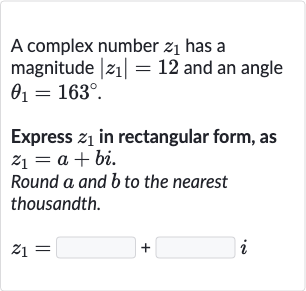Full solution
Q. A complex number has a magnitude and an angle .Express in rectangular form, as .Round and to the nearest thousandth.
- Convert angle to radians: To convert a complex number from polar to rectangular form, we use the equations and , where is the magnitude and is the angle in radians.
- Calculate theta in radians: First, we need to convert the angle from degrees to radians. The angle given is degrees. To convert degrees to radians, we multiply by . in radians =
- Calculate real part : Now we calculate the value of in radians. in radians
- Calculate value of a: Next, we calculate the real part of the complex number using the cosine of the angle.
- Calculate imaginary part b: Now we calculate the value of .
- Calculate value of b: Next, we calculate the imaginary part of the complex number using the sine of the angle.
- Round to nearest thousandth: Now we calculate the value of .
- Round to nearest thousandth: Now we calculate the value of .Finally, we round and to the nearest thousandth. (rounded to the nearest thousandth) (rounded to the nearest thousandth)
More problems from Compare linear and exponential growth
QuestionGet tutor help
QuestionGet tutor help
QuestionGet tutor help
QuestionGet tutor help
QuestionGet tutor help
QuestionGet tutor help
QuestionGet tutor help

